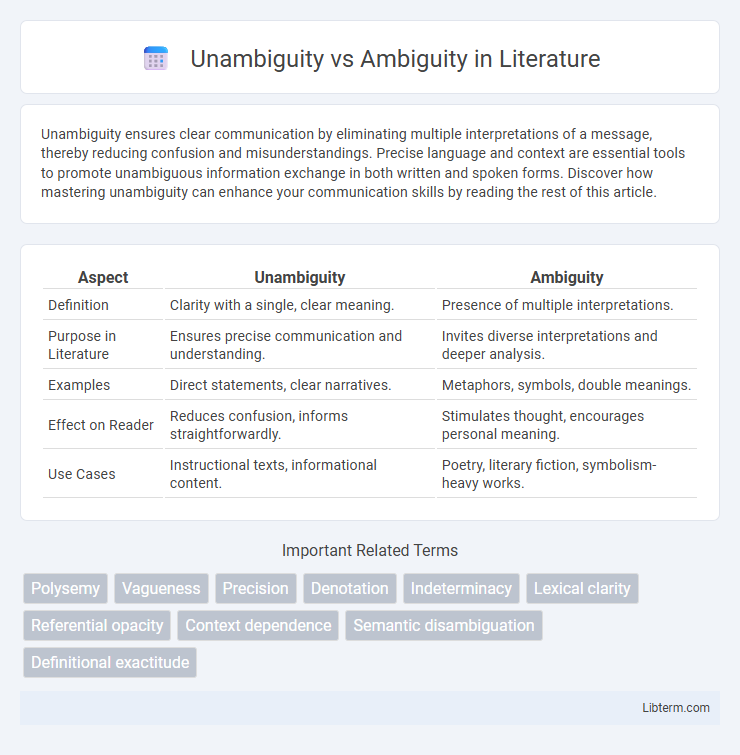Unambiguity ensures clear communication by eliminating multiple interpretations of a message, thereby reducing confusion and misunderstandings. Precise language and context are essential tools to promote unambiguous information exchange in both written and spoken forms. Discover how mastering unambiguity can enhance your communication skills by reading the rest of this article.
Table of Comparison
| Aspect | Unambiguity | Ambiguity |
|---|---|---|
| Definition | Clarity with a single, clear meaning. | Presence of multiple interpretations. |
| Purpose in Literature | Ensures precise communication and understanding. | Invites diverse interpretations and deeper analysis. |
| Examples | Direct statements, clear narratives. | Metaphors, symbols, double meanings. |
| Effect on Reader | Reduces confusion, informs straightforwardly. | Stimulates thought, encourages personal meaning. |
| Use Cases | Instructional texts, informational content. | Poetry, literary fiction, symbolism-heavy works. |
Understanding Unambiguity and Ambiguity
Unambiguity refers to clarity in meaning where information is precise and interpretations are limited to a single understanding, essential in technical communication and legal documents. Ambiguity occurs when language or data allows for multiple interpretations, often leading to confusion or varied perspectives in literature and everyday conversation. Understanding unambiguity and ambiguity helps improve communication by identifying when clarity is necessary and when multiple viewpoints add value.
Defining the Concepts: Unambiguity vs Ambiguity
Unambiguity refers to the clear and precise meaning of a term or expression that allows only one possible interpretation, ensuring effective communication and reducing misunderstandings. Ambiguity occurs when a word, phrase, or sentence can be interpreted in multiple ways, leading to potential confusion or varied perceptions. Understanding the distinction between unambiguity and ambiguity is crucial in fields like linguistics, computer science, and law, where clarity and precision are essential.
The Importance of Clear Communication
Clear communication minimizes ambiguity, ensuring messages are understood precisely as intended. Unambiguous language reduces misunderstandings, enhances collaboration, and improves decision-making in professional and personal contexts. Clarity in communication fosters trust, efficiency, and effective problem-solving across diverse audiences and industries.
Common Causes of Ambiguity
Ambiguity often arises from polysemy, where a single word possesses multiple meanings depending on the context, leading to confusion in interpretation. Syntactic ambiguity, caused by unclear sentence structure or punctuation, contributes significantly to miscommunication in both written and spoken language. Pronoun reference ambiguity occurs when it is unclear which noun a pronoun refers to, complicating comprehension and clarity in discourse.
Examples of Ambiguity in Everyday Life
Ambiguity frequently arises in everyday language, such as the phrase "I saw her duck," which can mean either observing a woman crouch or witnessing her pet waterfowl. Ambiguous road signs, like an unclear "No Parking" zone, cause confusion for drivers regarding when to park or not. In conversations, statements like "He gave her cat food" can be interpreted as either giving food to the woman's cat or feeding the woman with cat food, highlighting the common presence of ambiguity in daily communication.
Advantages of Unambiguous Language
Unambiguous language ensures clear communication by reducing misunderstandings and enhancing precision in conveying information. It improves efficiency in decision-making processes and legal interpretations, minimizing conflicts caused by multiple interpretations. Using unambiguous terminology is crucial in technical documentation, scientific research, and contractual agreements to maintain consistency and accuracy.
Risks and Challenges of Ambiguous Communication
Ambiguous communication often leads to misunderstandings, increasing the risk of errors and inefficiencies in decision-making processes. Teams faced with unclear messages may experience reduced trust and collaboration, resulting in delayed project timelines and higher operational costs. Effective risk management requires prioritizing unambiguous communication to minimize misinterpretations and ensure precise execution of tasks.
Strategies to Achieve Unambiguity
Strategies to achieve unambiguity include using precise and specific language that eliminates multiple interpretations and employing standardized terminology to maintain consistency across communication channels. Structuring sentences with clear grammar and avoiding vague expressions enhances clarity, while providing concrete examples or definitions ensures the intended meaning is understood. Utilizing feedback mechanisms such as confirmation and paraphrasing helps detect and resolve potential ambiguities early in the communication process.
Ambiguity in Legal and Technical Contexts
Ambiguity in legal and technical contexts often leads to differing interpretations, causing disputes, delays, and increased costs. Legal documents with ambiguous language can result in litigation as parties seek clarification of rights and obligations, while technical specifications lacking precision may lead to product failures or operational inefficiencies. Ensuring clarity through precise terminology and detailed definitions minimizes risks associated with ambiguous communication in these critical fields.
Choosing Between Ambiguity and Unambiguity
Choosing between ambiguity and unambiguity depends on the context and desired communication outcome. Unambiguity ensures clarity, reduces misunderstandings, and is critical in legal, technical, and academic writing where precision is paramount. Ambiguity can be strategically employed in creative writing, marketing, and diplomacy to evoke multiple interpretations and engage diverse audiences.
Unambiguity Infographic

 libterm.com
libterm.com